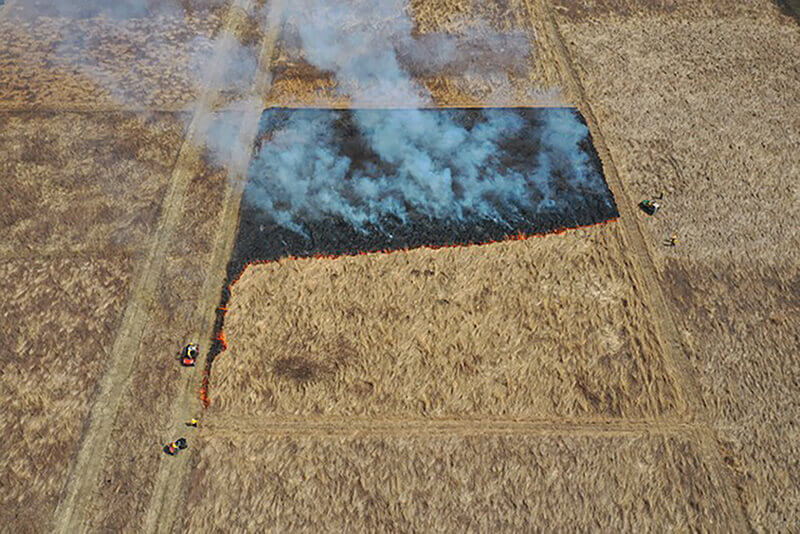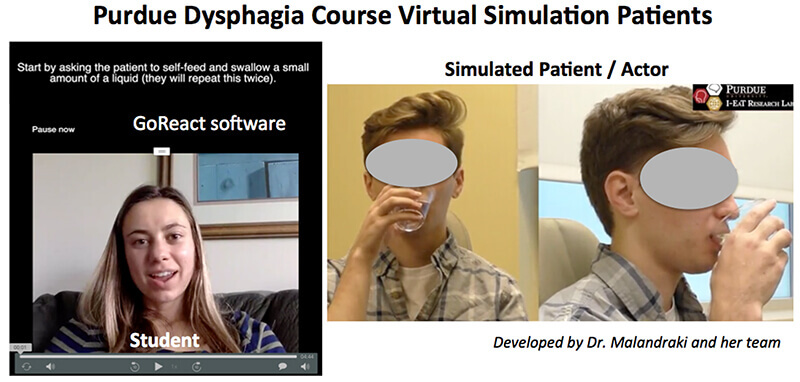April 29, 2020
Purdue classes make strong switch to online during COVID-19
What does that look like for construction management, fire in forest management and engineering labs?
WEST LAFAYETTE, Ind. — For Purdue University faculty, it was a two-week sprint.
The race started March 10, when President Mitch Daniels asked faculty to move 5,000 courses online by March 23. When classes resumed after spring break, students began attending virtually.
“What students experienced was the result of their professors’ resilience, determination – and creativity – to provide high-quality learning experiences remotely,” said Chantal Levesque-Bristol, executive director of the Center for Instructional Excellence. “Purdue’s established innovative learning approach and infrastructure provided the leverage to meet this challenge in record time.”
 A bird’s-eye view from a drone is how students learned about how to safely conduct prescribed fires during Jarred Brooke’s Fire Effects in Forest Environments class. (Photo provided by Jarred Brooke)
Download image
A bird’s-eye view from a drone is how students learned about how to safely conduct prescribed fires during Jarred Brooke’s Fire Effects in Forest Environments class. (Photo provided by Jarred Brooke)
Download image
Here are just a few examples of how Purdue adapted:
- Construction management: How many safety violations are there in HGTV shows?
- Fire effects in forest management: Drone footage takes students to burns. Video online.
- Speech sciences: Using telehealth and virtual patients.
- Engineering: Moving physical labs to virtual platforms.
Construction management
Like all Purdue faculty, instructors in construction management did significant brainstorming in the transition to online-only instruction.
Mark Zimpfer, assistant professor of practice in Purdue’s Polytechnic Institute, said his initial feeling of panic quickly turned to excitement. “It was a challenge,” he said. “When you have 30 years in the construction industry, you can say, ‘OK, this is like a construction problem. We had a plan, it changed, so how are we going to react?’”
In the Advanced Pre-Construction Management course that Zimpfer is teaching, he drills down into residential construction practices. For this class, he turned to a readily accessible resource: home makeover shows.
“There’s a massive quantity of instructional material available in these shows,” Zimpfer said. “It is excellent visual material, and it demonstrates construction around the world, both good and bad.”
As students watch shows like “First-time Flipper” and “Fixer Upper,” they do directed notetaking. “I have them write down things they would do differently – code violations or safety violations,” Zimpfer said. “It’s a great tool to let the student watch a jobsite critically and pick things apart, to analyze.”
Bringing the field into the classroom
Jarred Brooke is an extension wildlife specialist in Purdue’s Department of Forestry and Natural Resources. Each spring, he teaches an eight-week course called “Fire Effects in Forest Environments.” The course trains future natural resource professionals in prescribed burning, an essential tool for managing healthy forests. The first four weeks focus on fundamentals like the history and the value of the practice and how to plan a controlled burn.
The second half of the course, after spring break, is a rigorous four weeks in the field. Brooke and his students go off campus to examine ecosystems, practice using safety gear and equipment, step through their plans, and participate in live burns.
This spring, with fieldwork off limits, Brooke was determined to bring the fieldwork experience into an online learning environment.
“I put out a call on Twitter to all the people I know who work with prescribed fire, looking for videos, publications, anything I could use in class,” Brooke said. He got an overwhelming response. “I received resources from across the United States plus a few different countries.”
With imagery and video from diverse environments, Brooke was able to demonstrate a greater variety of controlled burns and techniques for his students, including video showing a 9,000-acre burn in Oregon. He used this and other footage to create individual videos illustrating specific things students would see if they were in the field.
“I had some amazing quality drone footage from previous burns that we did on Purdue property,” Brooke said. By introducing a bird’s-eye view, he enabled students to see controlled burns holistically, from a new perspective and in ways that they would have missed from the ground. And his students agree.
“The drone footage is super valuable,” said Elliott Sass, a senior double-majoring in forestry and agricultural engineering. “When you’re on the ground, you’re looking through the flames and the fuels. The drone footage gives a great visual representation, a big-picture outlook of what’s happening with the fire.”
 McKayla Schloemer, a graduate student clinician in a graduate-level dysphagia course in the Department of Speech, Languages and Hearing Sciences, completes an evaluation of a real-life virtual simulated patient developed using GoReact software. (Image provided by Georgia Malandraki)
Download image
McKayla Schloemer, a graduate student clinician in a graduate-level dysphagia course in the Department of Speech, Languages and Hearing Sciences, completes an evaluation of a real-life virtual simulated patient developed using GoReact software. (Image provided by Georgia Malandraki)
Download image
Telehealth and virtual patients
For Georgia Malandraki, associate professor of speech, language, and hearing sciences, the move to remote-only learning was validating. A researcher with expertise in telemedicine, she and professors Jessica Huber and Preeti Sivasankar recently spent a year and a half transforming her undergraduate course, Anatomy and Physiology of the Speech Mechanism, into a remote learning experience.
This spring, Malandraki is teaching a graduate-level course in dysphagia, swallowing disorders — which trains students in clinical behaviors and how to diagnose and treat these disorders. This is a course that includes both lectures and an interactive hands-on lab. When Malandraki learned she had one week to move the class online, she was determined to provide an outstanding experience.
McKayla Schloemer, a graduate student clinician taking Malandraki’s course this semester, said it has been a flawless transition.
“The way Professor Malandraki transitioned from in-class to online activities not only allows us to practice our clinical skills, but also allows us to practice telemedicine, which is where our field is heading,” Schloemer said.
In addition to moving all the remaining lectures online and creating experiential lab assignments that students could complete at home. Malandraki also used an instructional video software called GoReact to create interactive virtual patients. With help from a research assistant and her lab team, she incorporated the simulations into the graduate-level course.
In her online virtual simulation labs, students record themselves interacting with the simulated patients. “Students can practice clinical interviewing skills and clinical examination skills as well as interpreting imaging videos and making treatment recommendations for the virtual patients,” Malandraki said. “Creating real-life simulated patients was a big project, but it is working out really great, particularly now.”
“It’s like a face-to-face interaction with a patient,” Schloemer said. “The online instruction actually became more relevant. Especially with the coronavirus, our field is really moving towards telemedicine.”
Malandraki is pleased with the adaptations she has made and plans to incorporate them in future classes. “I absolutely value in-person education, but I think remote learning has a really important role to play,” she said. “Many remote techniques, such as simulated patients, are extremely valuable for clinical instruction.”
Engineering physical labs to virtual platforms
In 2016, the School of Aeronautics and Astronautics began the long-term process of developing virtual labs. The idea was to improve instruction by reinforcing material learned in heavily attended physical labs and to provide students access to experiments that can’t easily be performed on site, such as time-dependent loading tests.
When Waterloo Tsutsui, lecturer and lab coordinator in the School of Aeronautics and Astronautics, learned Purdue was moving to online-only instruction during COVID-19, he was gratified to know that he could continue providing high-quality instruction to students with virtual labs. “I was actually more worried about my lecture course,” he said.
The virtual lab setup is extensive, Tsutsui noted. Each course has its own lab, or set of labs. Some are available via a web browser; others are Purdue server-based applications that students access remotely.
Additionally, to communicate with students while everyone is working remotely, Tsutsui started using Piazza, an online Q&A discussion board. He was surprised how quickly his students adapted to it, and they use it extensively. As an instructor, he can see all the questions his students are asking in one place.
“In a class with 250 people, 250 people can benefit from one person’s question because when I write an answer, everybody can take a look at what this particular procedure should be,” Tsutsui said.
About Purdue University
Purdue University is a top public research institution developing practical solutions to today’s toughest challenges. Ranked the No. 6 Most Innovative University in the United States by U.S. News & World Report, Purdue delivers world-changing research and out-of-this-world discovery. Committed to hands-on and online, real-world learning, Purdue offers a transformative education to all. Committed to affordability and accessibility, Purdue has frozen tuition and most fees at 2012-13 levels, enabling more students than ever to graduate debt-free. See how Purdue never stops in the persistent pursuit of the next giant leap at purdue.edu.
Writer: Marti LaChance
Media contact: Amy Patterson Neubert, 765-412-0864, apatterson@purdue.edu
Sources: Chantal Levesque-Bristol, cbristol@purdue.edu
Jarred Brooke, jmbrooke@purdue.edu
Mark Zimpfer, mzimpfer@purdue.edu
Georgia Malandraki, malandraki@purdue.edu
Waterloo Tsutsui, wtsutsui@purdue.edu
Note to Journalists: Drone footage of a fire replicated the field experience for students in the virtual portion of the “Fire Effects in Forest Environments” course. This video is available online. An image from this course and an image from a graduate-level health course are also available for journalists to use in a Google Drive folder.

